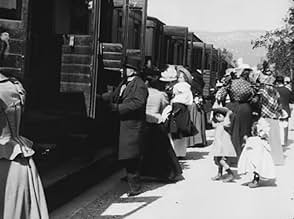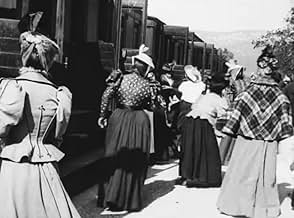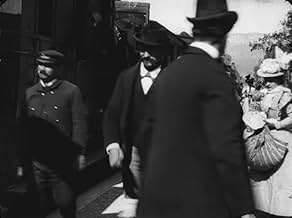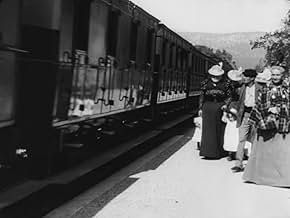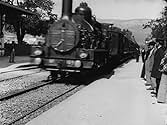CALIFICACIÓN DE IMDb
7.4/10
14 k
TU CALIFICACIÓN
Un tren llega a la estación La Ciotat.Un tren llega a la estación La Ciotat.Un tren llega a la estación La Ciotat.
Opiniones destacadas
At just under a minute, L'Arrivée d'un train à La Ciotat (1895) is one of Louis Lumiere's earliest excursions into film-making. As was formulaic with what he called "actualités," or non-narrative shorts, Louis Lumiere set up his cinematographe (a portable crank-handled camera that triples as a film projector and developer) at such an accomplished angle as to catch the arrival of a train at La Ciotat, where it captures the bustling comers-and-goers of the station who happen to stray in front of the lens, looking altogether curious, or else wary of the unfamiliar contraption. The crowd seems lively enough, but just for good measure, Lumiere's refined wife and mother-in-law can be seen actively searching for an imaginary, but eagerly expected passenger.
As uninteresting as it is (and it IS, even for the most pretentious film buff), L'Arrivée d'un train à La Ciotat's historical appeal is undeniable, if not legendary. The film's effect upon its first public viewing is a well-worn myth told to enthusiastic film students by their professors. Apparently, initial audiences, unaware of film's capacity to fully imitate reality, fled in fear of the image of a train barreling down upon the screen. The French newspaper, Le courrier du centre, (July 14, 1896) alleged the advancing locomotive made "spectators draw back instinctively fearing they'd be run over by the steel monster." Nevertheless, such a widespread and instantaneous physical response seems foolish or naïve even then, especially when the projector would have been visible and the sound audible to all seated in what at that time passed as a "theater." In reality, it is far more likely that this incident was limited to a few isolated cases, and was later exaggerated to enhance its appeal and boost the film's reputation. Consequently, the commerciality of the venture succeeded with tremendous results. Over a hundred years later, not only is L'Arrivée d'un train à La Ciotat a cinematic icon, but proof of how powerful and impressionable moving pictures could (and would) become.
Recommended for those with an interest in film as an art form, or for those looking for early examples of film in history.
As uninteresting as it is (and it IS, even for the most pretentious film buff), L'Arrivée d'un train à La Ciotat's historical appeal is undeniable, if not legendary. The film's effect upon its first public viewing is a well-worn myth told to enthusiastic film students by their professors. Apparently, initial audiences, unaware of film's capacity to fully imitate reality, fled in fear of the image of a train barreling down upon the screen. The French newspaper, Le courrier du centre, (July 14, 1896) alleged the advancing locomotive made "spectators draw back instinctively fearing they'd be run over by the steel monster." Nevertheless, such a widespread and instantaneous physical response seems foolish or naïve even then, especially when the projector would have been visible and the sound audible to all seated in what at that time passed as a "theater." In reality, it is far more likely that this incident was limited to a few isolated cases, and was later exaggerated to enhance its appeal and boost the film's reputation. Consequently, the commerciality of the venture succeeded with tremendous results. Over a hundred years later, not only is L'Arrivée d'un train à La Ciotat a cinematic icon, but proof of how powerful and impressionable moving pictures could (and would) become.
Recommended for those with an interest in film as an art form, or for those looking for early examples of film in history.
This footage of the "Arrival of a Train" is one of the most enduring images of the earliest years of cinema. The often-repeated accounts of the startled reactions to this movie from early audiences, along with the ways that such reactions were commemorated in other early movies such as "The Countryman and the Cinematograph", have made it one of the best-known of the earliest movies, and beyond that, the film in itself accomplishes its own aim very well.
The Lumières discovered very quickly how effective motion towards the camera could be, and that idea is certainly used to good effect here. The diagonal direction of the motion, necessitated by the material being filmed, gives it a distinctive character. Compared with the train, the crowd reactions here are a bit less interesting than they are in some of the other Lumière features that include crowds who know they are being filmed. A couple of them do acknowledge the camera as they go about their business.
Yet even today, the train grabs the viewer's notice, so that the crowd and other details get much less attention. That in itself shows how effectively this enduring classic was able to carry out an interesting idea.
The Lumières discovered very quickly how effective motion towards the camera could be, and that idea is certainly used to good effect here. The diagonal direction of the motion, necessitated by the material being filmed, gives it a distinctive character. Compared with the train, the crowd reactions here are a bit less interesting than they are in some of the other Lumière features that include crowds who know they are being filmed. A couple of them do acknowledge the camera as they go about their business.
Yet even today, the train grabs the viewer's notice, so that the crowd and other details get much less attention. That in itself shows how effectively this enduring classic was able to carry out an interesting idea.
On December 28, 1895, at Paris's Salon Indien Du Grand Café, the brothers Auguste and Louis Lumière transformed the industry of entertainment when they did a demonstration of their new invention. The brothers projected a series of images on a screen, but those images were nothing like a normal slide-show, those images were moving as if they were alive. While the idea of motion pictures wasn't new to the audience (Edison's Kinetoscope was a popular entertainment), the devise's ability to project them on a screen was something they had never seen before. 10 short films of barely a minute of duration each were shown that day, and the invention proved to be an enormous success for the brothers, so immediately they decide to keep making movies in order to improve their catalog. One of those new movies would become the first iconic image of the new art.
"L' Arrivée d'un train à La Ciotat" (literally, "Arrival of a Train at La Ciotat") is without a doubt, one of the most famous films in history, as its image of a train arriving to the station, passing very close to the camera as it slows its speed, quickly became an iconic scene of the new invention. While initially conceived as just another one of the brothers' many "actuality films", it's clear that director Louis Lumière knew exactly where to put his camera in order to get the best image of the event as the film shows he had a good idea of the use of perspective (many consider it a study about long shot, medium shot and close-up). As a side-note, this is the film that originated the classic urban legend about people running away scared from the arriving train, thinking it was a real locomotive what was appearing on the screen.
While this famous tale has been debunked by historians as a fake story, it's existence is another testament of this movie's importance and continuous influence on the younger generations. Among the many different art-forms that we can find today, cinema is perhaps the one that better reflects the modern society that arose after the industrial revolution of the 19th Century; because, as painting and sculpture did before, it has become a keeper of the most representative icons of our history. "L' Arrivée d'un train à La Ciotat" was not the first movie the brothers screened, and it definitely wasn't the first movie ever made, but despite those details, the image of the arriving train represents the first icon of cinema, and literally, the arrival of a new art form. 9/10
"L' Arrivée d'un train à La Ciotat" (literally, "Arrival of a Train at La Ciotat") is without a doubt, one of the most famous films in history, as its image of a train arriving to the station, passing very close to the camera as it slows its speed, quickly became an iconic scene of the new invention. While initially conceived as just another one of the brothers' many "actuality films", it's clear that director Louis Lumière knew exactly where to put his camera in order to get the best image of the event as the film shows he had a good idea of the use of perspective (many consider it a study about long shot, medium shot and close-up). As a side-note, this is the film that originated the classic urban legend about people running away scared from the arriving train, thinking it was a real locomotive what was appearing on the screen.
While this famous tale has been debunked by historians as a fake story, it's existence is another testament of this movie's importance and continuous influence on the younger generations. Among the many different art-forms that we can find today, cinema is perhaps the one that better reflects the modern society that arose after the industrial revolution of the 19th Century; because, as painting and sculpture did before, it has become a keeper of the most representative icons of our history. "L' Arrivée d'un train à La Ciotat" was not the first movie the brothers screened, and it definitely wasn't the first movie ever made, but despite those details, the image of the arriving train represents the first icon of cinema, and literally, the arrival of a new art form. 9/10
I have little to add to other reviewers, except to say that this film took a sudden importance in my life last year. In 2002 I was travelling by train to my first ever Cannes Film Festival. At one point the train was moving slowly and I looked out of the window and found that we were pulling through La Ciotat, and the platform hadn't changed a bit. Sadly the train didn't stop, otherwise I would have been tempted to jump off for a moment, but given the purpose of my journey I felt a strange thrill at being there. Just a little personal anecdote, but perhaps it shows something of the power and importance of those early steps in film.
The other reviewers are correct that this is a remarkable piece of history, but it is not the first movie. What film earns that honor depends partly on how you define movies. If you consider Edison's Kinetoscope shorts to be movies, the first movies were from 1893. And even before Edison, there had been some experimentation with projected motion pictures. Even if you give the Lumiere brothers credit for inventing the form (which is a very reasonable decision, but not an inevitable one), I believe their first film was "Workers Leaving The Factory" (aka " Sortie des usines Lumière, La (1895) ") Also, according to the "Oxford History of World Cinema", reports that terrified audience members hid under their seats when the film was first shown are probably apocryphal. Still, this (and the Lumiere brothers other early shorts) are well worth seeing for anyone who loves movies.
¿Sabías que…?
- TriviaPopular legend has it that, when this film was shown, the audience fled in terror, fearing being run over by the "approaching" train. This legend has since been identified as promotional embellishment, though there is evidence to suggest that people were astounded at the capabilities of the Lumières' cinématographe.
- ConexionesEdited into Louis Lumière (1968)
Selecciones populares
Inicia sesión para calificar y agrega a la lista de videos para obtener recomendaciones personalizadas
Detalles
- Tiempo de ejecución
- 1min
- Color
- Mezcla de sonido
- Relación de aspecto
- 1.31 : 1
Contribuir a esta página
Sugiere una edición o agrega el contenido que falta

